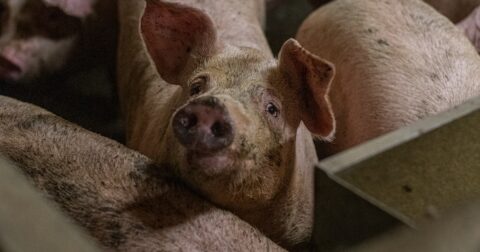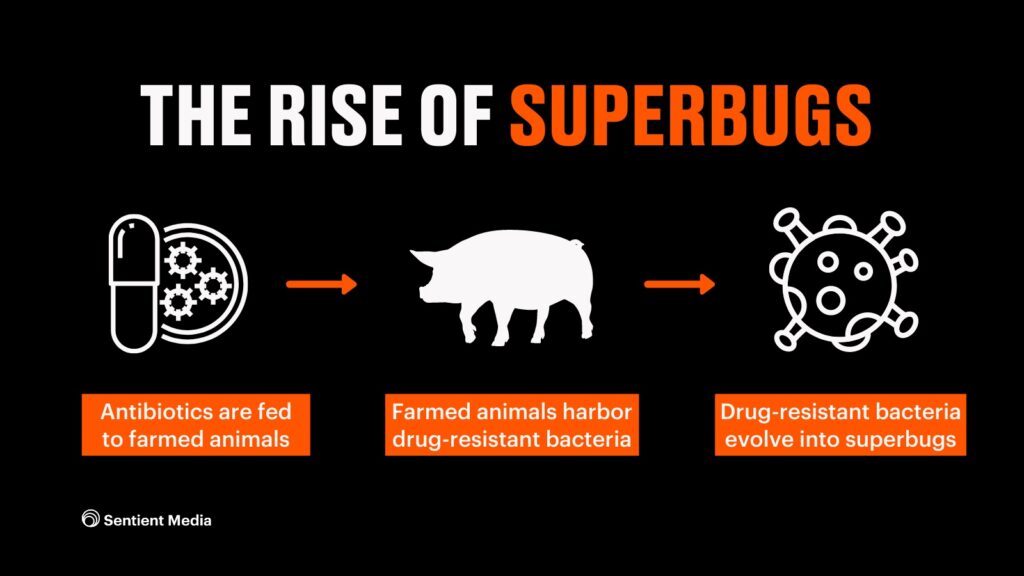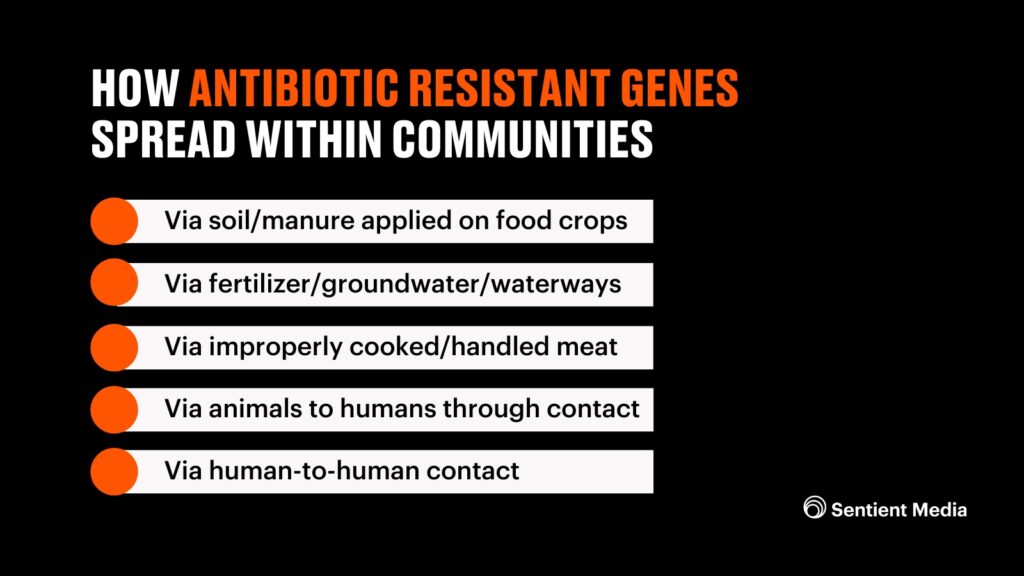Explainer
What Are Hot Dogs Made Of?
Health•6 min read
Reported
The widespread use of antibiotics on factory farms is exposing everyone who lives within a 3-mile radius to significant health risks. Low-income people of color are often the most affected.


Words by Devatha P. Nair
There are a few counties in the central plains of North Carolina that can easily be mistaken for the hog capital of the world. Housing over 40 percent of the state’s hog population of 9 million, hogs outnumber people 29 to one. These counties are home to numerous concentrated animal feeding operations—called CAFOs or factory farms—that make North Carolina the second-biggest pork producer in the United States.
Not coincidentally, this distinction comes at the cost of the residents who live in the vicinity of factory farms within these counties, who are predominantly African American, Native American, and Latino. With per capita incomes and education levels well below the national average, the proliferation of factory farms within low-income minority communities has raised valid concerns of environmental injustice. In a 2017 review of North Carolina’s meat industry, the Environmental Protection Agency cited a “linear relationship between race/ethnicity and density of hogs” in these counties and their disproportionate impact on communities of color.
The health impacts that accompany factory farms are life-altering to the communities that live within a 3-mile radius of these intensive operations. In addition to being plagued by the sounds of shrieking, miserable animals, the smell of feces and urine, and poor air quality, residents often complain of stomach aches, headaches, higher rates of nausea, watery eyes, along with feelings of anxiety and depression from the constant assault on their senses. A recent investigative study by the World Animal Protection (WAP) group emphasizes that the physical and mental ailments of area residents are only the tip of the iceberg: there are more significant and far-reaching impacts on the global community as a direct result of practices on factory farms. The report is referring to the widespread use of antibiotics on factory farms that have led to the growth of antibiotic-resistant bacteria which is a cause for grave global concern.
Animals are the main unit of production on factory farms. To protect their product, farmers enlist the help of antibiotic drugs, which are used to prevent the onset and spread of disease among stressed animals. This is more commonly known as the prophylactic or subtherapeutic use of antibiotics. While the use of antibiotics on animals with no preexisting illness may appear to be for the welfare of farmed animals, the liberal use of antibiotics is aimed at maximizing profits by fattening the animals within short periods and maintaining them with some resemblance of health while being kept in overcrowded, unhygienic, and ill-maintained facilities.
This practice has been so successful that 75 percent of antimicrobials in the U.S. are marketed to animal farms. However, this indiscriminate use of antibiotics has resulted in many bacteria that have grown resistant to life-saving antibiotic drugs, which are often the last line of defense for humans fighting bacterial infections. The alarming growth of resistant bacteria—called superbugs—has compelled several global organizations to act, with the World Health Organization (WHO) listing superbugs and drug-resistant microbes as one among the top ten global threats to human health, along with climate change and global pandemics.
The WHO acknowledges that the indiscriminate use of antibiotics to promote growth and prevent disease in factory farms has contributed significantly to the emergence and propagation of superbugs to human and non-human animal populations. As a matter of global urgency, they have listed a series of drugs that are critically and highly important to human health. With their highly adept survival mechanisms, bacteria that developed resistant genes to specific antibiotics—called antibiotic-resistant genes or ARG—are not only able to outsmart the antibiotic drugs but are also able to pass on the resistance genes from one species to another. The presence of ARG in bacteria is an indication of the growing antibiotic resistance in the organism.
The WAP group has been closely following and reporting on the link between factory farms and the alarming growth of superbugs and ARG over the past few years. In December 2018, as part of a global investigation, the group tested pork samples from stores in the mid-Atlantic region of the United States for the presence of bacteria resistant to specific antibiotics. E. coli, Salmonella, Enterococcus, and Listeria were found in 94 percent of the 160 pork samples tested. While 41 of the 51 bacteria isolated from the pork samples were resistant to at least one class of medically important antibiotics, 21 bacteria were resistant to three or more classes of antibiotics.
In their most recent report published in April 2021, the group has detailed disturbing findings from a study in October 2020, in which 45 water samples and 45 soil samples were taken across eight sites, both upstream and downstream from factory farms in North Carolina, and tested for the presence of ARG. The communities that live near these sites have complained for over three decades of both, the detrimental impact that the factory farms have had on their health and the associated lack of justice and action that have accompanied their complaints.

When thousands of gallons of manure are sprayed onto fields eight feet from your kitchen window, the strong smell and taste of manure and ammonia contaminate your drinking water and lingers in the air for days afterward, ensuring that no children are playing outside and there are no barbeques with family and friends. Within a short time, the aerosolized manure builds up on the exterior of your house and across your property, attracting clouds of insects, especially flies. However, testing for ARG in water and soil samples in the vicinity of factory farms has not been prioritized to date. Alarmingly, the WAP report found that all 90 samples tested returned a positive result for at least one ARG, with resistance to tetracyclines identified in 89 out of 90 samples, and 23 out of 90 samples had one or more ARG to antibiotics identified by WHO as critically and highly important, such as cephalosporins and penicillin.
“The implications of antibiotic resistance throughout the environment near large factory farms are extremely concerning,” says Cameron Harsh, Farming Campaign Manager, World Animal Protection U.S. “The contamination of waterways and air puts nearby communities at high risk. Drug residues and resistant bacteria do not obey the boundaries of the farm operation. They are carried away via the waste stored in lagoons or sprayed on fields, on insects, rodents, and other wildlife, on farmworkers headed home to their families, and on the animals processed for our food, potentially spreading resistance to other bacteria as they persist and travel.”
Because the same antibiotics used to mask poor animal welfare practices—such as the lack of hygiene and overcrowding on farms—can also be used as growth enhancers on factory farms, there is an ever-greater incentive to use antibiotics to speed up operations while enhancing the quality of meat. For example, the use of antibiotics can facilitate the growth of a pig to his slaughter weight of 250-280 pounds in less than 6 months, which is a mere fraction of his natural 15 to 20-year lifespan.
An inconvenient by-product of treating animals as meat production units with artificially short lifespans is the sheer amount of animal waste generated on factory farms. More than 2 billion tons of animal waste, which consists of both solid and liquid waste, is generated on animal farms each year, and storing and maintaining animal waste until it can be more easily displaced is challenging. Animal waste in factory farms is often stored in poorly engineered tanks and massive, open-air cesspools (misleadingly called lagoons) while awaiting treatment and disposal. These ill-maintained, gigantic tanks—some as large as seven acres and totaling anywhere between 20 to 45 million gallons of waste—often leak and spill into the adjacent water bodies and the groundwater.

When the fecal mixture is sprayed as manure on food crops, they enter the soil, the groundwater, adjacent waterways, and the air. As farmed animals discharge up to 70 percent of the antibiotics they are fed via urine and feces, factory farms’ biological waste is heavily concentrated with active antibiotic drugs that enter the environment in multiple ways. It is the antibiotics that have inadvertently entered the environment—be it the air, soil, water, or food streams—that pose a grave risk of producing antibiotic-resistant bacteria or superbugs.
The superbugs know no boundaries and invariably end up infecting humans and other non-human animals, setting off a cascade of detrimental events. Each year, 700,000 human deaths worldwide are attributed to antibiotic-resistant infections and more than 10 million people are projected to die annually from treatment-resistant bacteria by 2050. In the U.S., antibiotic-resistant bacteria claim a life every 15 minutes, with 35,000 deaths and more than 2.8 million infections reported annually.
The World Animal Protection report summarizes their findings by pointing out that both enhancing the standards for animal welfare practices and the dependence on antibiotics in factory farming operations must be addressed in tandem to see any meaningful reduction in antibiotic use in our food systems. It is only by eliminating the worst animal abuse practices in factory farming such as cage confinement, painful physical alterations, weaning animals from their mothers too young, and using high growth breeds that tangible reductions in total antibiotics used in farmed animals can be achieved.
Developing stronger antibiotics and novel waste treatment technologies cannot be the long-term solution towards eradicating superbugs while the factory farms continue to rely relentlessly on antibiotics without addressing cruel practices currently employed to maximize profits and meet the demand for animal protein. Both governmental and intergovernmental organizations, along with financial investors in the food industry can be more proactive in setting the standards for animal welfare, establishing checks and balances for implementing the animal welfare policies in farms while simultaneously monitoring, enforcing, and reporting accurately on the use and consumption of antibiotics in factory farms. The report also suggests that financial stakeholders in the food industry consider increasing the proportion of plant-based protein in their investment portfolio to support an average global reduction in meat production and consumption of 50 percent by 2040.
Given the vast consortium of stakeholders in the food industry, their profit margins, and the inevitable resistance that will be encountered in implementing any reforms that reduce profits within the current paradigms, it is easy to overlook the principal stakeholder—sentient beings—whose short life and welfare are at the center of this paradigm. What cannot be as easily ignored are the clear and far-reaching impacts of the ill-conceived, profit-driven practice of overusing antibiotics on farmed animals. The antibiotic use that enables the mistreatment of pigs has now crossed the ill-kept barriers of factory farms and seeped into communities via leaky lagoons, contaminated groundwater, and polluted air and soil ecosystems, resulting in the alarming rise of ARG in bacteria. The greed-driven practices on factory farms can no longer be dismissed as geographically isolated, “one-off” instances of environmental racism or poor animal welfare. If unchecked, ARG will continue to spread globally with devastating consequences to both human and non-human animals.